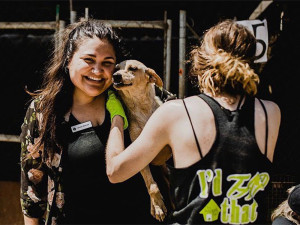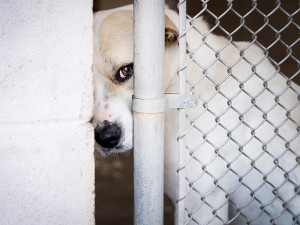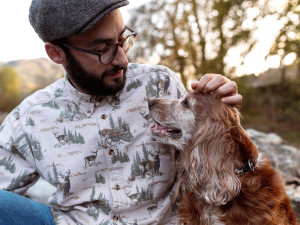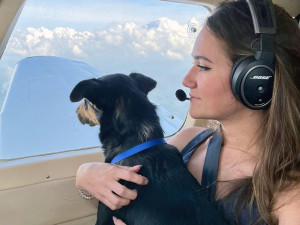Where Have All the Fosters Gone?
This is the Paula Cole parody that rescue orgs are singing as they struggle to find people to foster pets.
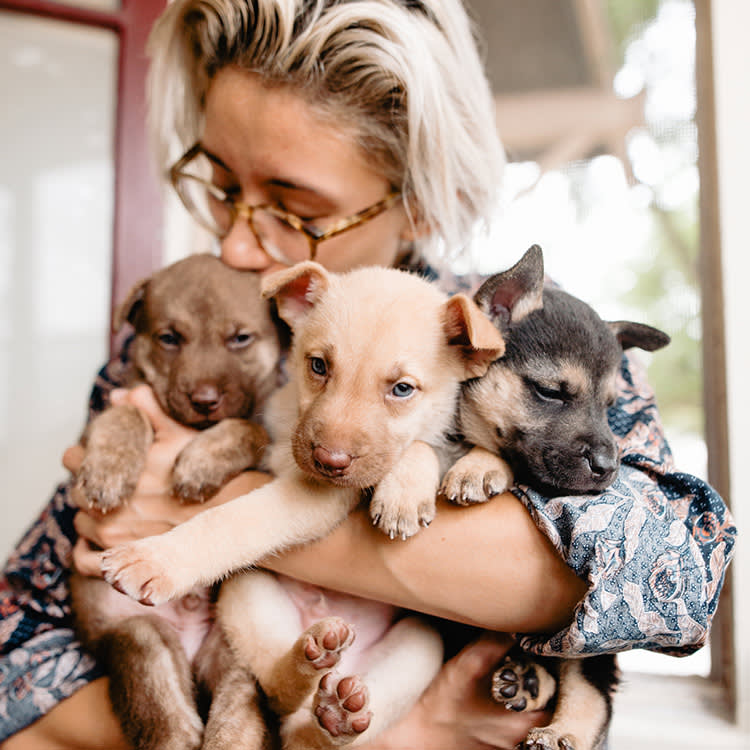
Share Article
Before the pandemic, if Patricia Hough, Foster Director at the volunteer and foster-based animal rescue Rescue Dogs Rock NYCopens in new tab, was told she had to place 60 rescue dogs with foster families in a week, “it was no problem.” She tells Kinship that, historically, her network of fosters in states from Virginia to Maine has been strong and always willing to open their doors to a new dog in need.
The past couple of years, however, have been a different story.
“Now it’s very difficult,” Hough says. “They used to call me a magician. Well, I’m not a magician anymore. My wand is broken; it’s in the repair shop and has been for the past two years.”
She’s not the only one who has noticed a recent shift in foster availability. “Now that everything is seemingly back to normal, in terms of being in-person again, at work, we have a major [foster] shortage happening,” Lauren Botticelli, Director of The Animal Pad — an all-breed, nonprofit Dog Rescue Organization based in San Diego — tells Kinship.

Blame it on COVID.
So, what happened?
Maybe the most obvious reason for a decline in fosters in recent years is the global event that turned just about everything as we knew it on its axis: the COVID-19 pandemic.
At first, the pandemic greatly benefited animal rescues and shelters in terms of foster and adopter availability and interest. Botticelli estimated the Animal Pad was getting “maybe 30 foster applications a day, at minimum” at the height of the pandemic — numbers the organization had never seen before. She says that, in 2020, the organization also “quadrupled” the number of dogs they rescued and adopted out. That year alone, they rescued 1,300 dogs, compared to the 360 dogs they rescued in 2019.
Many other shelters opens in new tab and rescues reportedlyopens in new tab adopted out pets in record numbers during the height of the pandemic, too. In fact, a 2021 ASPCA surveyopens in new tab found that 23 million Americans — about one in five households — acquired a pet during the COVID-19 pandemic.
As heartening as that number is, it may be one reason why rescues and shelters are struggling to find fosters now. Botticelli observed that many fosters “foster-failed,” or adopted the dog they fostered, during the pandemic. She adds that this scenario is “awesome when it happens,” but “a lot of times you do lose a foster when they decide that they are keeping the dog.”
The pandemic also seems to have shifted potential fosters’, and even adopters’, sense of their ability to foster. “I think that people are under a severe misconception that you have to have a yard or work from home to foster, and that’s not the case at all,” Botticelli says. “Pre-pandemic, none of our fosters worked from home. Dogs have to be crated during the day when the foster parents are gone, and that’s OK. The alternative is that they don’t make it out of the shelter or off of the streets. Crated in a warm, safe home is amazing for them.”
Hough has also run into this misconception among fosters and adopters. “All those years prior to the pandemic, people worked in the offices, and they still filled out applications,” Hough muses. “Most of them had a dog walker; if not, we supplied a dog walker.”
Volunteers decline, but needs for fosters only increase.
The shortage of fosters is compounded by a heartbreaking rise in dogs in need of fosters. Returns of dogs adopted during the pandemic have been on the riseopens in new tab: In the first nine months of 2022, more animals entered shelters than left them by a margin of 7.3 percent, according to a reportopens in new tab by the nonprofit Shelter Animals Count. The reasons for these returns are varied but include the rising inflation rate. According to a recent Lending Tree surveyopens in new tab, a quarter of pet parents are struggling to afford the cost of their pet amid inflation, and nearly 25 percent have taken on debt from pet care. Many feel they have no option but to return their pets to rescues or shelters.
Botticelli and Hough have also seen dogs returned for less dire reasons, too. Hough says some adopters returned their dogs because, as they return to the office and their social lives, their dogs struggle with “separation anxiety because [the adopter had been] home every single day throughout COVID” and adopters don’t feel equipped, or aren’t interested, in training or helping their dogs with this problem.
Botticelli has also seen adopters opt to return dogs rather than work on training them. “It’s sad,” she says. “Because these were the dogs that saved some of our lives during this time when we were feeling really down and needed a friend and companion, and now these dogs are being returned to us because they’re not what the owners are wanting and they’re not willing to put the work in.”
No matter why these pets are returned, they only add to the number of dogs in rescues and shelters — and rescues and shelters haven’t stopped rescuing dogs in need. This leaves rescues with more dogs in need of fosters than available fosters and, in the case of many shelters, more dogs than shelter space.
The story seems to be slightly different for shelters, compared to foster-based rescue organizations. While organizations like The Animal Pad rescued more dogs than ever during the pandemic, according to dataopens in new tab collected by Best Friends Animal Society and 24PetWatch, approximately 20 percent fewer pets were adopted from shelters in 2020 than in 2019. This is, in large part, because shelters saw 32 percent fewer dog intakes and 23 percent fewer cat intakes, and animal control was less active in picking up strays during the health crisis.
Shelters, however, are also now in need of fosters. When shelters were below capacity during the pandemic, many “didn’t need new foster homes as much,” Brent Toellner, senior director of National Programs for Best Friends Animal Society tells Kinship. Now, Toellner says, “people who were fosters before got out of the habit of fostering, or their lifestyles changed, so it’s no longer as easy for them. Meanwhile, shelters weren’t recruiting replacement fosters.”
Blame it on the algorithm, too.
But the pandemic and all of its effects aren’t the only reason behind the foster shortage. Hough, Botticelli, and Tolner all point to changing social media algorithms as a huge impediment to recruiting and engaging fosters. “Many social media platforms (like Facebook) have changed their algorithms so that only a small fraction of a shelter or rescue’s followers see the pleas for help,” Tollner says.
Hough has also noticed that changes in algorithms have affected what her community can see from Rescue Dogs Rocks’ social profiles. “If I posted something, I used to have a couple thousand views,” she says. “Now, maybe I have 50, sometimes seven.”
Perhaps, according to Brett Tollner, this indicates that the foster shortage isn’t a shortage at all but a recruitment issue. “Every person in a community is a potential foster — and we certainly aren’t running out of people,” he says.
Rescues are trying to find more creative ways to get the word out. The Animal Pad is handing out fliers at dog parks and doggie daycares and will soon hand out in other public spaces. They’re also accepting fosters from farther distances than they once did, including those who live as much as two hours away. “We tried to keep our fosters close for vetting purposes, for emergency purposes,” Botticelli says. “But it’s slim pickings now, so we’ve had to make some changes.”
Rescues must also continue dispelling myths about fostering that may deter potential fosters. A huge one: that fosters will have to pay their dog’s vet bills. “We pay for medical [bills], it just has to be a rescue-friendly vet,” Hough clarifies.
Many rescues are even open to paying for other expenses, like food. “Some of my fosters take more than one dog at once — a bonded pair, two or three — I’ll get food to them because the help is needed,” Hough says. “And all help is welcome at this point.”
“I think there’s also probably a misconception that all [dogs in need of fosters] have major issues, and that’s not the case,” Botticelli says. While fostering isn’t always easy, and every dog has different needs, she adds that “there are so many resources that our rescue provides that makes it an easier process for you.”
Why are foster volunteers important?
This shortage might beg a central question: Why do we need fosters at all? Why not focus on expanding shelter space, for example?
Per Botticelli, foster-based rescuing is important because it allows the rescue to “know a little about how the dog will be in a home much more than if you just go and pluck a dog from a shelter and expect them to be a certain way in your house. So, we’re doing that pre-work for adopters so they can find out if that dog is potentially a good fit in their home before they even meet the dog based on our foster’s feedback.”
What’s more, many rescue organizations, like Korean K9 in New York City, can only function because fosters take in dogs; they don’t have facilities at all. At the risk of stating the obvious: Foster-based organizations can’t rescue dogs without...fosters.
The lack of fosters affects shelters, too; because of overcrowding in shelters nationwide, many are reconsideringopens in new tab their euthanasia policies — or euthanizing more than they previously had. In these cases, fosters can help save lives.
For now, there’s only one option. As Patricia Hough puts it, “I just continue to do what I do. I work hard. I don’t give up. I ask for help now with posting and networking. We would save every dog if we could.”

Julie Zeilinger
Julie Zeilinger is a writer and editor whose writing has been published in Marie Claire, Forbes, Vox, HuffPost, and other publications. She is also the author of two books: College 101: A Girl’s Guide to Freshman Year (2014) and A Little F’d Up: Why Feminism Is Not a Dirty Word (2012). She has a two-year-old Bichpoo named Baloo and is a foster mom to dogs via Badass Animal Rescue.
Related articles
![A woman smiling with a dog at an animal rescue service event.]()
As Shelters Fill Up With Dogs, The Animal Pad Volunteers Roll Up Their Sleeves
The San Diego-based rescue’s 300 volunteers take saving Mexican street dogs as seriously as a full-time job (but have fun doing it).
![Happy Labrador Retriever sitting on the floor]()
Did You Know 25% of Shelter Dogs Are Purebred?
If your heart is set on a purebred pup, start your search at breed-specific rescue organizations.
![]()
How Korean K9 Gives Dogs Rescued From the Meat Trade a Second Shot at Life
The rescue’s founder, Gina Boehler, on her mission to help these pups start over.
![Black woman smiling and holding a Siamese cat which is looking into the camera]()
CARE Is Amplifying BIPOC Voices to Keep People and Pets Together
“We don’t consider what we are doing animal welfare work. We are taking a holistic approach to well-being for animals and humans.”
![woman holding beautiful cat]()
3 Sustainability Reasons to Adopt Your Next Pet From a Shelter
If your New Year’s resolution is to go green, consider animal rescue.
![A brunette woman holding a black dog with a blue collar, she is wearing headphones and a microphone attachment while seated in a plane with the clouds and sky showing through the window]()
Pilots to the Rescue Has Flown Nearly 400 Animals to Safety This Year
With the help of flight, this nonprofit is saving animals and relocating them to loving homes across the country.
